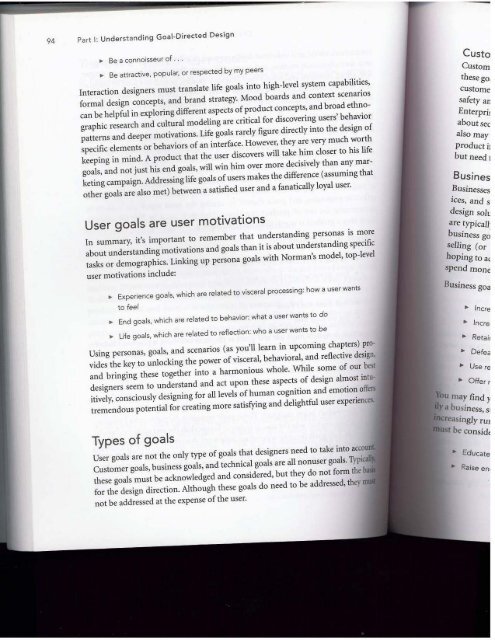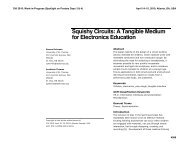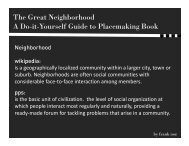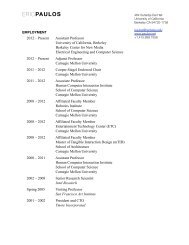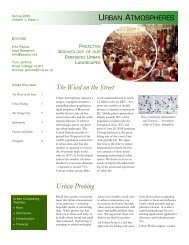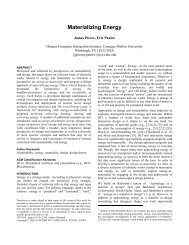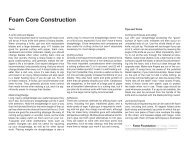Chapter 5: Modeling Users: Personas and Goals
Chapter 5: Modeling Users: Personas and Goals
Chapter 5: Modeling Users: Personas and Goals
Create successful ePaper yourself
Turn your PDF publications into a flip-book with our unique Google optimized e-Paper software.
94 Part I: Underst<strong>and</strong>ing Goal-Directed Design<br />
.. Be a connoisseur of .<br />
,. Be attractive. popular. or respected by my peers<br />
Interaction designers must translate life goals into high-level system capabilities,<br />
formal design concepts, <strong>and</strong> br<strong>and</strong> strategy. Mood boards <strong>and</strong> context scenarios<br />
can be helpful in exploring different aspects ofproduct concepts, <strong>and</strong> broad ethnographic<br />
research <strong>and</strong> cultural modeling are critical for discovering users' behavior<br />
patterns <strong>and</strong> deeper motivations. Life goals rarely figure directly into the design of<br />
specific elements or behaviors of an interface. However, they are very much worth<br />
keeping in mind. A product that the user discovers will take him closer to his life<br />
goals. <strong>and</strong> not just his end goals, will win him over more decisively than any marketing<br />
campaign. Addressing life goals ofusers makes the difference (assuming that<br />
other goals are also met) between a satisfied user <strong>and</strong> a fanatically loyal user.<br />
User goals are user motivations<br />
In summary, it's important to remember that underst<strong>and</strong>ing personas is more<br />
about underst<strong>and</strong>ing motivations <strong>and</strong> goals than it is about underst<strong>and</strong>ing specific<br />
tasks or demographics. Linking up persona goals with Norman's model. top-level<br />
user motivations include:<br />
,. Experience goals. which are related to visceral processing: how a user wants<br />
to feel<br />
.. End goals. which are related to behavior: what a user wants to do<br />
,. Life goals, which are related to reflection: who a user wants to be<br />
Using personas, goals. <strong>and</strong> scenarios (as you'll learn in upcoming chapters) provides<br />
the key to unlocking the power of visceral. behavioral. <strong>and</strong> reflective design,<br />
<strong>and</strong> bringing these together into a harmonious whole. While some of our best<br />
designers seem to underst<strong>and</strong> <strong>and</strong> act upon these aspects of design almost intuitively,<br />
consciously designing for all levels of human cognition <strong>and</strong> emotion offers<br />
tremendous potential for creating more satisfying <strong>and</strong> delightful user experiences.<br />
Types of goals<br />
User goals are not the only type of goals that designers need to take into accou<br />
Customer goals, business goals. <strong>and</strong> technical goals are all nonuser goals. Typic<br />
these goals must be acknowledged <strong>and</strong> considered, but they do not form the<br />
for the design direction. Although these goals do need to be addressed, they<br />
not be addressed at the expense ofthe user.<br />
Custo<br />
Custom<br />
these go.<br />
Custome<br />
safety an<br />
Enterpri!<br />
about Sec<br />
also may<br />
product ij<br />
but need 1<br />
Busines<br />
Businesses<br />
Ices, <strong>and</strong> s<br />
design solt<br />
are typicall<br />
business g~<br />
selling (or<br />
hoping tOa,<br />
spend mane<br />
Business goa<br />
.. Jncre<br />
,. Incre.<br />
• Retail<br />
• Defea<br />
• Use re<br />
• Offer r<br />
u may find y<br />
ab . usmess, Sl<br />
reasingly rUI<br />
t be considt<br />
.. Educate<br />
• Raise en,


